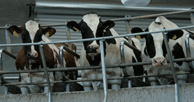 Pennsylvania was the lone state among the top 23 that did not boost milk flow when this March was compared to the same time last year. The Keystone state's reduction was quite small, 0.6 percent.
Pennsylvania was the lone state among the top 23 that did not boost milk flow when this March was compared to the same time last year. The Keystone state's reduction was quite small, 0.6 percent. All other states bolstered milk output with the western states again leading the charge. On a percentage basis, Utah rose, 7.8 percent; Colorado, 7.1 percent; Arizona, 6.6 percent; California, 6.2 percent; and Texas, 5.7 percent. Next month's milk production report will be interesting to watch. As you read in a previous blog, this will be the last USDA milk production report before some of California's additional delivery constraints go into effect. For more details, go to http://www.hoards.com/blog_West-Coast-in-milk
Michigan was the lone nonwestern state to squeeze among leaders for improved milk output. The Wolverine state rose 7.3 percent in March, ranking it second among all states.
A great deal of the enhanced production was due to greater output per cow. When compared to last March, milk per cow rose 3.2 percent.
Meanwhile, the national dairy herd grew by 1 percent, rising 86,000 head. All the growth came from the leading 23 dairy states which were up 94,000 head which means the remaining 27 states were down 16,000 head.
Among the nation's other top dairy states, Wisconsin boosted output 4.2 percent, Idaho up 3.3 percent, and New York grew 3.1 percent.
Idaho showed the lowest improvement for states located west of the Rockies. Some of that could be due to lower returns when compared to their counterparts. In 2010, potato-land dairy producers averaged $19 net income per cow . . . a return of 9 cents per hundredweight. That same Genske, Mulder & Company study found the next lowest-revenue state netted $200 more per cow or almost one full dollar more per hundredweight. When the numbers for 2011 are available, the story would be much the same on the return front.









